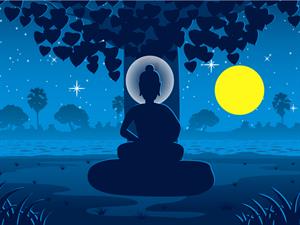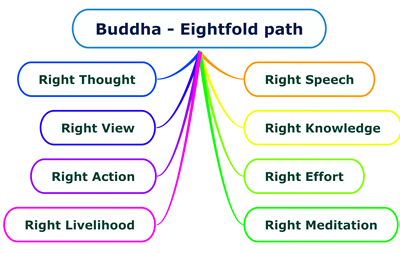PDF chapter test TRY NOW
The Dawn of Buddhism:
The Ideological supremacy displayed by the upper-class Brahmanas and other castes, rigid caste system and killing cows in the name of sacrifice significantly impacted the lives of people performing agriculture. This social unrest led to the emergence of new religions like Buddhism.
This religion counterattacked the ideological dominance of the upper class and went on to win over people from all walks of life. Buddhism is a 2600 years old religion that still prevails in South and South-East Asia.
The Birth of Gautama Siddhartha:
The Royal Prince of the Sakhya clan was born in Lumbini near Kapilavasthu in modern-day Nepal in the year 567 BCE.
His real name was Siddhartha, who later acquired the name Buddha and was credited as the founder of Buddhism. He was also known as the “Sakhya Muni”, as he was born in the Sakhya clan.
After losing his mother, Mayadevi, seven days post his birth, he was raised by his step-mother Gautami. Gautama married Yasodhara at the age of 16 and led a normal life of Prince in Lumbini.
He renounced his prince-hood at the age of 29, where the incidents he witnessed at this age shocked his existence. He left his family and embraced Sainthood.

The sightings of these incidents gave Gautama a rude shock while he was taking stock of his empire. He was highly attracted to the emotional balance of the ascetic, which influenced him to detach himself from worldly attachments.
The Enlightenment:
After renouncing his princely life in 537 BC, Gautama embraces the life of an ascetic who believed in attaining supreme knowledge through meditation.

The Enlightened Buddha
Gautama sat under the “Pipal tree” and undertook rigorous meditation, which brought him the desired result of “Enlightenment” during his 49^t^h day of the meditation.
Gautama Buddha: He attained the Enlightenment under the Pipal tree located in Bodh Gaya (Bihar) on the banks of the river “Niranjana”.
He discovered the truths of life through the process of meditation, which made him a noble soul. After attaining the Enlightenment, he was known by the name of “Buddha – the Enlightened one”.

The First Sermon of Buddha
After attaining the Enlightenment, Buddha delivered his first Sermon in the Deer Park located at Saranath (UP). He also visited the kingdoms of Kosala and Magadha and preached his ideas.
His First Sermon was about the “Dharma Chakra Pravartana” or “Turning the Wheels of Law”.
The Preachings of Buddha:
After attaining the state of Enlightenment, Buddha began spreading the knowledge of the truth that he had acquired from his meditation among the people of all the classes as they were under the veil of ignorance.
These tenets of Buddha later came to be known as the Noble truths, as they are universally appealing among the masses.
Four noble truths of Buddha:
1. Life in the world is full of sorrow and misery.
2. Desire is the root cause of all miseries.
3. Suffering of oneself can be erased if they give up their desire.
4. The Desire can be conquered by adopting the Right path (Eight-fold Path)
Buddha firmly believed that the desire of humans was the ultimate cause of their sufferings and regrets.
According to Buddha, a person’s quest to attain Nirvana or Supreme bliss can be attained by following the eight noble truths or the Eight-Fold path.

Buddha decided to spread the truths of life he acquired through rigorous meditative practices. For that purpose, he had established an association of monks (who were known as “Bikhus/ Bikhuni’s).
Buddhism spread its horizons to Tibet, Sri Lanka, China, Japan, Vietnam and other Central and Southeast Asian countries.
